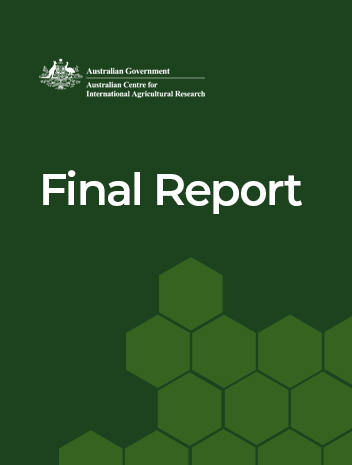- HomeHome
-
About ACIAR
- Our work
- Our people
-
Corporate information
- ACIAR Audit Committee
- Commission for International Agricultural Research
- Policy Advisory Council
- Agency reviews
- Executive remuneration disclosure
- Freedom of information (FOI)
- Gifts and benefits register
- Information publication scheme
- List of new agency files
- Contracts
- Legal services expenditure
- Privacy impact assessment register
- Commonwealth Child Safe Framework
- Benefits to Australia
- Careers
- 40 years of ACIAR
-
What we do
- Programs
- Cross-cutting areas
- Resources
- Where we work
-
Funding
- Research projects
- Fellowships
-
Scholarships
- John Allwright FellowshipScholarships to study in Australia for ACIAR partner country scientists to have Australian postgraduate qualifications
- ACIAR Pacific Agriculture Scholarships and Support and Climate Resilience Program
- Alumni Research Support Facility
- Publications
- News and Outreach
Project final report
An integrated approach for systemic change and sustained development of the Papua New Guinea sweetpotato value chain - Final Report
Date released
10 April 2017
ISBN
978-1-86320-017-2
Publication Code
ASEM/2011/048
Overview
The aim of the project was to improve the economic returns and income of sweetpotato farmers and other supply chain players, through adoption of improved sweetpotato postharvest and marketing practices.
Sweetpotato is the major staple food crop in Papua New Guinea, and surpluses have historically been sold at local markets. However, increasingly sweetpotato is grown specifically for the markets in urban centres, such as Lae and Port Moresby, where demand for good quality sweetpotato is increasing due to economic growth and urbanisation. However, marketing opportunities have been constrained by the transport system and marketing infrastructure, as well as limited postharvest management, value chain coordination, and market orientation on the part of farmers and value chain players.
The main research questions to be answered by the project were:
- What are the most effective ways of reducing postharvest losses and the costs of marketing?
- What are the major constraints to the adoption of postharvest technologies, and to group marketing and collective action?
- What are the most appropriate strategies to overcome those constraints?
- What are the potential impacts of planned interventions on smallholder farmers?



